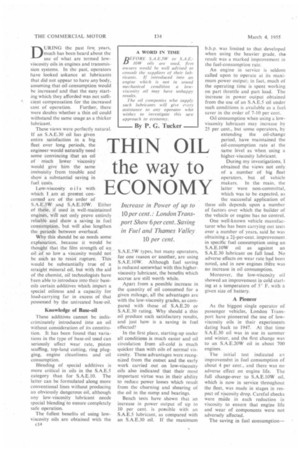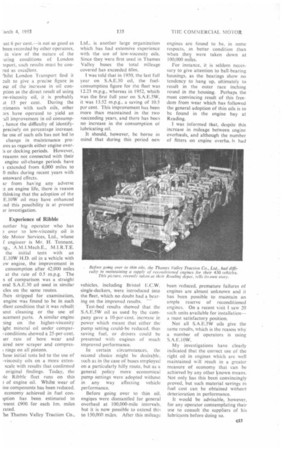THIN OIL
Page 52

Page 53

If you've noticed an error in this article please click here to report it so we can fix it.
the way to
ECONOMY
Increase in Power of up to 10 per cent.: London Transport Show 6 per cent. Saving in Fuel and Thames Valley 10 per cent. DURING the past few. years, much has been heard about the use of what are termed lowviscosity oils in engines and transmission systems. In the past, operators have looked askance at lubricants that did not appear to have any body, assuming that oil consumption would be increased and that the easy starting which they afforded was not sufficient compensation for the increased
cost of operation. Further, there were doubts whether a thin oil could withstand the same usage as a thicker lubricant.
These views were perfectly natural. If an S.A.E.30 oil has given entire satisfaction in a big fleet over long periods, the engineer would naturally need some convincing that an oil of much lower viscosity would give him the same immunity from trouble and show a substantial saving in fuel costs.
Low-viscosity oils with which I am at present concerned are of the order of S.A.E.5W .and S.A.E.I0W. Either of these, if used in well-maintained engines, will not only prove entirely reliable and show a sa:ving in fuel consumption, but will also lengthen the periods between overhaul.
Why this should be so needs some explanation, because it would be thought that the film strength of an oil of so low a viscosity would not be such as to resist rupture. This would be substantially true of a straight mineral oil, but with the aid of the chemist, oil technologists have been able to introduce into their baseoils certain additives which impart a special oiliness and a capacity for load-carrying far in excess of that possessed by the untreated base-oil.
Knowledge of Base-oil
These additives cannot be indiscriminately introduced into an oil without consideration of its constitution. It has been found that variations in the type of base-oil used can seriously affect wear rate, piston scuffing, top-land cutting, ring plugging, engine cleanliness and oil consumption.
Blending of special additives is more critical in oils in the S.A.E.S category than for S.A.E.10. The latter can be formulated along more conventional lines without producing an obviously dangerous oil, although any low-viscosity lubricant needs special blending to ensure completely safe operation.
The fullest benefits of using lowviscosity oils are obtained with the cia S.A.E.5W types, but many operators, for one reason or another, are using S.A.E.10W. Although fuel saving is reduced somewhat with this higherviscosity lubricant, the benefits which accrue are still worth while.
Apart from a possible increase in the quantity of oil consumed for a given mileage, all the advantages are with the low-viscosity grades, as compared with those of S.A.E.20 or S.A.E.30 rating. Why should a thin oil produce such satisfactory results, and just how is a saving in fuel effected?
In the first place, starting-up under all conditions is much easier and oil circulation from all-cold is much quicker than with oils of normal viscosity. These advantages were recognized from the outset and the early work carried out on low-viscosity oils also indicated that their most important virtue was in their ability to reduce power losses which result from the churning and shearing of the oil in the sump and bearings.
Bench tests have shown that an increase in power output of up to 10 per cent, is possible with an S.A.E.S lubricant, as compared with an S.A.E.30 oil. If the maximum b.h.p. was limited to that developed when using the heavier grade, the result was a marked improvement in the fuel-consumption rate.
An engine in service is seldom called upon to operate at its maximum power output: in fact, much of the operating time is spent working on part throttle and part load. The increase in power output obtained from the use of an S.A.E.S oil under such conditions is available as a fuel, saver in the order of 7-10 per cent.
Oil consumption when using a lowviscosity lubricant may increase by 25 per cent., but some operators, by extending the oil-change period, have maintained the oil-consumption rate at the same level as when using a higher-viscosity lubricant.
During my investigations, I obtained the views not only of a number of big fleet operators, but of vehicle makers. In the main, the latter were non-committal, which was to be expected, as the successful application of these oils depends upon a number of factors over which the builder of the vehicle or engine has no control.
One well-known vehicle manufacturer who has been carrying out tests over a number of years, said he was obtaining a 2f-per-cent. improvement in specific fuel consumption using an S.A.E.10W oil as against an S.A.E.30 lubricant on full load. No adverse effects on wear rate had been noted, and in new engines there was no increase in oil consumption.
Moreover, the low-viscosity oil showed an improvement in cold starting at a temperature of 5° F. with a given size of battery.
A Pioneer
As the biggest single operator of passenger vehicles, London Transport have pioneered the use of lowviscosity oils in their experiments dating back to 1947. At that time S.A.E.30 oil was in use in summer and winter, and the first change was to an S.A.E.20W oil in about 700 engines.
The initial test indicated an improvement in fuel consumption of about 4 per cent., and there was no adverse effect on engine life. The full change-over to S.A.E.10W oil, which is now in service throughout the fleet, was made in stages in respect of viscosity drop. Careful checks were made in each reduction in viscosity to ensure that engine life and wear of components were not adversely affected.
The saving in fuel consumption— ast 6 per cent.--is not so good as been recorded by other operators, in view of the nature of the -ating conditions of London 3sport, such results must be conred as excellent.
rhilst London Transport find it r..'ult to give a precise figure in et of the increase in oil conption as the direct result of using )w-viscosity oil, it is probably it 15 per cent. During the :riments With such oils, other rs have operated to yield an all improvement in oil consump, hence the difficulty of identifyprecisely on percentage increase. he use of such oils has not led lo change in maintenance protres as regards either engine overis or docking periods. However, reasons not connected with their engine oil-change periods have I extended from 6,000 miles to 0 miles during recent years with intoward effects.
at from having any adverse :t on engine life, there is reason thinking that the adoption of the E.10W oil may have enhanced ,nd this possibility is at present ._•r investigation.
Experience of Ribble
nother big operator who has over to low-viscosity oil is Ole Motor Services, Ltd., whose I engineer is Mr. H. Tennant, 3g., Aisil.1.Mech.E., M.I.R.T.E. the initial tests with an ,ElOW H.D. oil in a vehicle with ew engine, the improvement in consumption after 42,000 miles at the rate of 0.5 m.p.g. The s of comparison was a straight eral S.A.E.30 oil used in similar cies on the same routes.
Then stripped for examination, engine was found to be in such :tient condition that it was rebuilt iout cleaning or the use of acement parts. A similar engine ling on the higher-viscosity ight mineral oil under comparconditions showed a 25-per-cent. ter rate of bore wear and tired new scraper and cornpres[ rings on all pistons.
hese initial tests led to the use of -viscosity oils on a more extenscale with results that confirmed original findings. Today, the ile Ribble fleet runs on this of engine oil. Whilst wear of ine components has been reduced. economy achieved in fuel eonlotion has been estimated to -esent £900. for each 1m. miles rated.
he Thames Valley Traction Co., Ltd., is another large organization which has had extensive experience with the use of low-viscosity oils. Since they were first used in Thames Valley buses the total mileage covered has exceeded 60m.
I was told that in 1950, the last full year on S.A.E.30 oil, the fuelconsumption figure for the fleet was 12.23 m.p.g., whereas in 1952, which was the first full year on S.A.E.5W, it was 13.52 m.p.g., a saving of 10.5 per cent. This improvement has been more than maintained in the two .succeeding years, and there has been no increase in the consumption of lubricating oil.
. It should, however, be borne in mind that during this period new vehicles, including Bristol E.C.W. single-deckers, were introduced into the fleet, which no doubt had a bear ing on the improved results.
Test-bed results showed that the S.A.E.5W oil as used by the company gave a 10-per-cent. increase in power which meant that either the pump setting couldbe reduced, thus saving fuel, or drivers could be presented with engines of much improved performance.
In certain circumstances, the second choice might be desirable, such as in the case of buses employed on a particularly hilly route, hut as a general policy more economical pump settings were adopted without in any way affecting vehicle performance.
Before going over to thin oil, engines were dismantled for general overhaul at 100,000-mile intervals, but it is now possible to extend this to 150,000 miles. After this mileage engines are found to be, in some respects, in better condition than when .they were taken down at 100,000 miles.
For instance, it is seldom necessary to give attention to ball-bearing housings, as the bearings show no tendency to hang up, ultimately to result in the outer race inching round in the housing. Perhaps the most convincing result of this freedom from wear which has followed the general adoption of thin oils is to be found in the engine bay at Reading.
I was informed that, despite this increase in mileage between engine overhauls, and although the number of fitters on engine overha. Is had been reduced, premature failures of engines are almost unknown and it has been possible to maintain an ample reserve of reconditioned engines. On a recent visit I saw 20 such units available for installation— a most satisfactory position.
Not all S.A.E.5W oils give the same results, which is the reason why a number of operators is using S.A.E.10W.
My investigations have clearly indicated that the correct use of the right oil in engines which are well maintained will result in a greater measure of economy that can be achieved by any other known means. Not only has this been convincingly proved, but such material savings in fuel cost can be obtained withouz deterioration in performance.
It would be advisable, however, for any operator comtemplating their use to consult the suppliers of his lubricants before doing so.












































































































